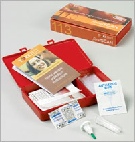



Helping you make healthy choices for you and your family

Food Intolerance
Disclaimer: The information in this article should not be regarded as medical advice. If you are receiving medical treatment or taking prescribed medication, you are advised to consult your GP or health practitioner before making any changes to your diet or lifestyle.

Most people are aware of the dangers of an allergic reaction to foods such as peanuts or shellfish. In the UK, this is a serious condition for around 1.5% of the population. However, a study by the organization, Allergy UK, suggests that up to 45% of the population may be affected by a food intolerance or sensitivity.
Food intolerance is gradually gaining recognition as a genuine health issue, thanks to a number of clinical studies and new diagnostic screening tests, pioneered in the UK.
Food intolerance is gradually gaining recognition as a genuine health issue, thanks to a number of clinical studies and new diagnostic screening tests, pioneered in the UK.
There are significant differences between a food allergy and a food intolerance. An allergic reaction usually happens rapidly after consumption or contact with a certain food. The lips or throat may swell, a rash may appear on the skin, or the person may vomit or have difficulty breathing. If medical treatment is not administered within minutes, the symptoms become life-threatening.
In the case of food intolerance, a reaction can occur from two hours to a few days after consuming a certain food. This delayed reaction can make it very difficult to pinpoint which food, or foods may be the cause.
The symptoms of food intolerance are not as severe as with food allergy but they can still be debilitating and cause much distress. Symptoms that may suggest food intolerance are:
|
|
Abdominal Pain
|
|
|
Aches and pains
|
|
|
Acne
|
|
|
Asthma
|
|
|
Arthritis
|
|
|
Autism
|
|
|
Bloating
|
|
|
Constipation
|
|
|
Chronic Fatigue
|
|
|
Depression
|
|
|
Diarrhoea
|
|
|
Eczema
|
|
|
IBS
|
|
|
Glue Ear
|
|
|
Headaches
|
|
|
Hyperactivity
|
|
|
Migraine
|
|
|
Psoriasis
|
|
|
Rashes
|
|
|
Restless legs
|
|
|
Sinusitis
|
|
|
Weight Loss
|

The most common food intolerances are dairy, wheat (gluten), nuts, eggs, tomatoes, citrus fruits, potatoes, certain fish or meats, and soya.
If you suspect you may have a food intolerance, it may be worth keeping a food diary for about four weeks. You need to write down everything you eat and drink and include a comment on any symptoms you may experience during the course of each day. By doing this, you may be able to identify a pattern. The next stage would be to eliminate the possible food. If no change is noticed after a week or two, then that food may be reintroduced and another food eliminated.
This process can become very tiresome and many people give up without identifying the real cause. There is also a danger of restricting your diet of essential nutrients, so any food that is eliminated should be replaced by a nutritious alternative. For example, an alternative to milk could be rice, oat, coconut or almond milk.
If you suspect you may have a food intolerance, it may be worth keeping a food diary for about four weeks. You need to write down everything you eat and drink and include a comment on any symptoms you may experience during the course of each day. By doing this, you may be able to identify a pattern. The next stage would be to eliminate the possible food. If no change is noticed after a week or two, then that food may be reintroduced and another food eliminated.
This process can become very tiresome and many people give up without identifying the real cause. There is also a danger of restricting your diet of essential nutrients, so any food that is eliminated should be replaced by a nutritious alternative. For example, an alternative to milk could be rice, oat, coconut or almond milk.
A much easier and quicker way to identify a food intolerance is through a blood test for Immunoglobulin G (IgG). Your local nutritionist may be able to arrange that for you. It is a simple test that only requires a finger prick blood sample which you can do yourself at home, then send to a laboratory for analysis.
| Your Health Your Future |
| Controversial Ingredients |
| Nutritional State |
| Parent and Child |
| Microwave Ovens |
| Recommended Books |
| Skin Absorption |
| Sodium Lauryl Sulphate |
| Propylene Glycol |
| DEA, MEA, TEA |
| Chemical Calculator |
| Fluoride |
| Aspartame |
| Fluoridation |
| Water Filtration |
| Planning a Pregnancy |
| Pregnancy Care |
| Post Pregnancy Care |
| Amazon Books |
| EBooks |
| About Us |
| Health Services |
